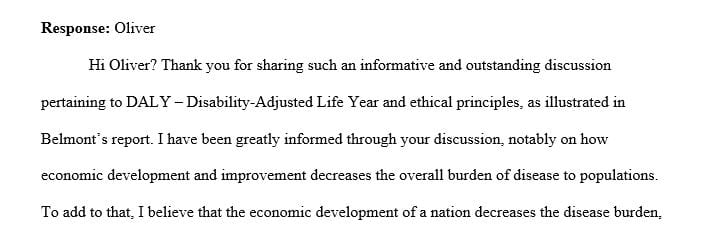Discussion: Definition of DALY represents the combination of years missed due to early death plus the years that were lived with a chronic condition leading to disability.
Discussion: Definition of DALY represents the combination of years missed due to early death plus the years that were lived with a chronic condition leading to disability.
ORDER NOW FOR CUSTOMIZED AND ORIGINAL ESSAY PAPERS
RESPOND TO OLIVER
Definition of DALY represents the combination of years missed due to early death plus the years that were lived with a chronic condition leading to disability. The years without a healthy life can define DALY as well according to Skolnik (2020)
According to Skolnik (2020) as countries develop economically, what are the most important changes that occur in their burden of disease.
With the country’s economic improvement and development, it has been observed that there is a general
decrease in the population’s disease burden. Additionally, economic progress ultimately leads to improved health facilities and medical technology available to health professionals for diagnosis of diseases and increased opportunities for better treatment of said diseases. High income countries tend to have better neonatal care as well as adequate nutrients in the population’s diet. Consequently average life span increases and mortality rate decrease as motioned by Skolnik (2020).
Explain the three ethical principles stated in Belmont report by Skolnik (2020). Give an example of a
research study shows how the three principles apply to it.
Over 45 years have passed since the Belmont report was publicized. The three ethical principles are:
Respect for persons by treating a person as good as should be treated and letting the person decide for
what it is convenient or not to themselves. Beneficence is the second basic ethical principle and is intended to produce good or helpful effects as well as promoting well-being in individuals. By practicing this ethical principle, damage or injury is prevented or decreased. Justice is the third ethical principal publicized by Belmont and includes being able to distribute all the benefits and burdens of research with integrity and fairness according to Skolnik (2020).
The Tuskegee study is an example of research that did not follow the Belmont Principals. There is not
“Respect for Persons” as evidenced by researchers lying to the male study participants when they said
they were treating them for their syphilis infections.
The denial of syphilis treatment for the participants is a complete lack of “beneficence”. The men were
given medicine that had no curative effects for syphilis. Risk were not reduced to achieve the research
objectives. Rather, risks were increased when researchers decided not to treat any of the men.
While penicillin became available and could have been used for the treatment of participants, it was not.
There was not “Justice” in this act and so justice took place 40 years after when the NAACP sought a $9
million settlement for survivors participants as well as the promise from the government to give medical
service to widows and families to the infected individuals due to the study.
Answer preview to definition of DALY represents the combination of years missed due to early death plus the years that were lived with a chronic condition leading to disability.



0 comments